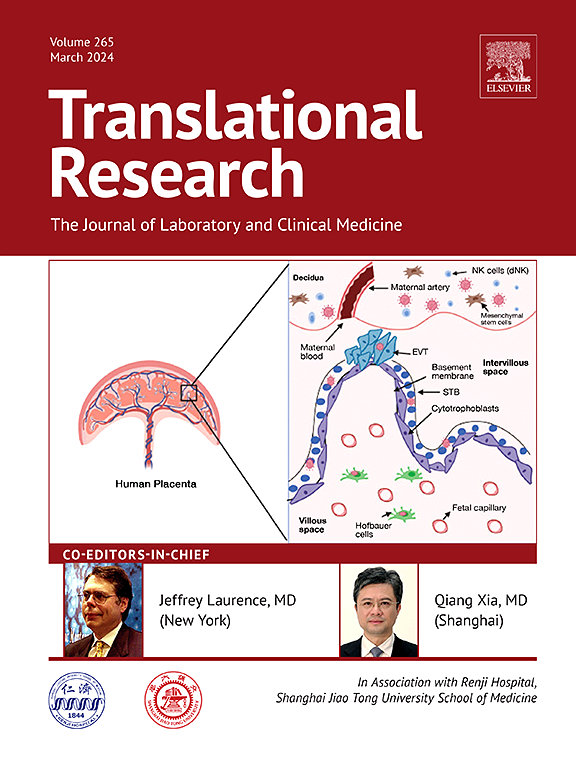Angiogenic and reparative potency of a human cardiac CD90− mesenchymal subpopulation in heart ischemic model
IF 5.9
2区 医学
Q1 MEDICAL LABORATORY TECHNOLOGY
引用次数: 0
Abstract
Background
Despite recent significant therapeutic progress, cardiovascular diseases (CVD) remain an unmet clinical, economic, and social burden worldwide. Cell-based therapies have been proposed as therapeutic strategies, however, the overall efficacy was modest.
Objective
We aimed to fully characterize a novel subpopulation of CD90− mesenchymal cells derived from human heart tissue (hCmPC90-) and evaluate its ability to induce cardiac tissue repair and functional recovery.
Methods
We performed a comprehensive phenotypic characterization of the hCmPC90− by flow cytometry and RNA sequencing. A direct comparison of hCmPC90− with previously clinically tested bone marrow- and cardiac-derived cell types, has been conducted both in vitro by means of various assays of angiogenic potency, and in vivo, by testing the ability to ameliorate left ventricular function in a mouse model of acute myocardial infarction (AMI).
Results
hCmPC90− showed distinct surface markers and transcriptional phenotype compared with unselected mesenchymal heart cells (hCmPCs) and the positive CD90 counterpart (hCmPC90+). When human hCmPC90−, hCmPC90+, hCmPC, cardiosphere-derived cells (CDCs), and bone marrow-derived CD34+ cells were functionally tested in vitro, hCmPC90− revealed a superior endothelial differentiation ability, higher anti-inflammatory, cardio-protective capacity, and angiocrine activity. Moreover, hCmPC90− showed specific immune-privileged features. When intramyocardially delivered into infarcted mouse hearts, hCmPC90− outperformed three weeks after injection other clinical-grade cell types, as for left ventricular (LV) function and adverse LV remodeling recovery, infarct size reduction, and vascular density augmentation.
Conclusion
hCmPC90− shows a superior biological potency which deserves clinical exploitation as an advanced therapy medicinal product in the context of refractory ischemic heart disease.
人心脏CD90-间充质亚群在心脏缺血模型中的血管生成和修复能力。
背景:尽管近年来心血管疾病的治疗取得了重大进展,但在世界范围内,心血管疾病(CVD)仍然是一个未满足的临床、经济和社会负担。细胞疗法已被提出作为治疗策略,然而,总体疗效一般。目的:我们旨在充分表征来自人类心脏组织的CD90-间充质细胞(hCmPC90-)的新亚群,并评估其诱导心脏组织修复和功能恢复的能力。方法:我们通过流式细胞术和RNA测序对hCmPC90-进行了全面的表型表征。hCmPC90与先前临床测试的骨髓和心脏来源的细胞类型进行了直接比较,在体外通过各种血管生成效力测定,在体内通过测试急性心肌梗死(AMI)小鼠模型中改善左心室功能的能力。结果:与未选择的间充质心脏细胞(hCmPCs)和CD90阳性对应细胞(hCmPC90+)相比,hCmPC90-表现出不同的表面标记和转录表型。在体外对人hCmPC90-、hCmPC90+、hCmPC、心球源性细胞(CDCs)和骨髓源性CD34+细胞进行功能测试时,hCmPC90-显示出优越的内皮分化能力、更高的抗炎、心脏保护能力和血管分泌活性。此外,hCmPC90-表现出特异性免疫特权特征。当心肌内注入梗死小鼠心脏时,hCmPC90-在左室(LV)功能和不良左室重塑恢复、梗死面积缩小和血管密度增加方面的表现优于注射后三周的其他临床级细胞类型。结论:hCmPC90-具有优越的生物学效力,值得作为治疗顽固性缺血性心脏病的先进药物进行临床开发。
本文章由计算机程序翻译,如有差异,请以英文原文为准。
求助全文
约1分钟内获得全文
求助全文
来源期刊

Translational Research
医学-医学:内科
CiteScore
15.70
自引率
0.00%
发文量
195
审稿时长
14 days
期刊介绍:
Translational Research (formerly The Journal of Laboratory and Clinical Medicine) delivers original investigations in the broad fields of laboratory, clinical, and public health research. Published monthly since 1915, it keeps readers up-to-date on significant biomedical research from all subspecialties of medicine.
 求助内容:
求助内容: 应助结果提醒方式:
应助结果提醒方式:


